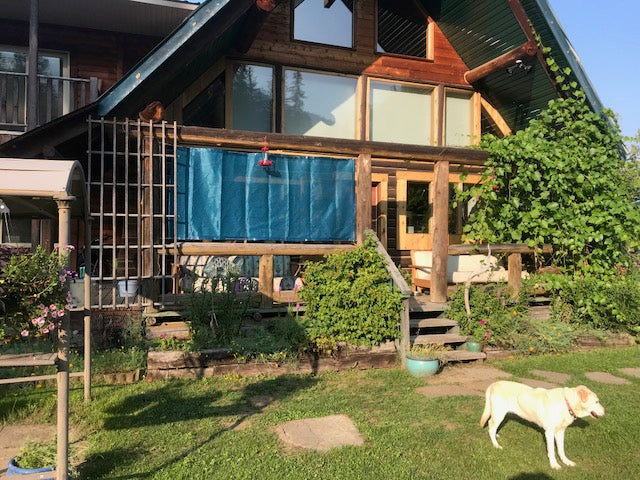Our YouTube channel includes detailed installation guides, frequently asked questions, product overviews and lots more. We are always open to content ideas so please let us know if there is a topic you would like us to cover.
5 Simple Tips for Creating More Privacy on Your Patio

Take Back Your Privacy with Patio Screens
Outdoor spaces like patios, decks, and balconies offer the perfect escape—until prying eyes turn your private retreat into a public display. As neighborhoods grow denser, finding solitude in your own backyard can be a challenge. The good news? You don’t need to build walls to create a more secluded, peaceful space.
In this article, we’ll explore 5 effective tips for using patio privacy screens to transform your outdoor area into a cozy, stylish, and private haven.
What is a Patio Privacy Screen?
A patio privacy screen is an easy and affordable way to add shade and privacy to your outdoor space. It also adds style and can be customized to fit your backyard décor. These screens come in different materials, sizes, and designs, so it’s easy to find one that suits your needs.
While they’re sometimes confused with balcony covers or outdoor screens, each has its own purpose. A balcony cover is usually fixed in place and offers shade and weather protection. An outdoor screen is portable and can be moved as needed.
In contrast, a patio privacy screen is made to block outside views, offering a more private, enclosed feel—plus added protection from wind and UV rays.

Materials for Patio Privacy Screens
One of the most popular materials for patio privacy screens is a shade fabric. This type of fabric is designed to provide both privacy and shade. It is made from high-density polyethylene (HDPE) and is suitable for outdoor use due to its durability and resistance to UV rays. Shade fabric can also be used for pergolas, fences and awnings, making it a versatile option for creating privacy in a variety of outdoor spaces. It comes in different colors and densities, giving you the flexibility to choose the level of privacy and shade you desire.
5 Simple Tips for Creating More Privacy on Your Patio
Now that we have cleared up any confusion about patio privacy screens, let’s dive into our 5 simple tips for creating more privacy on your patio.
1. Choose the Right Placement
The placement of your patio privacy screen is crucial in achieving maximum privacy. Start by assessing the layout of your outdoor space and identifying the areas that require more privacy. This can include areas where you spend most of your time, such as a seating area or outdoor dining space. You can also consider placing the screen strategically to block the view from any nearby windows or balconies. Additionally, make sure to leave enough space between the screen and any furniture or plants, as this will create an illusion of more space while still providing privacy.
2. Consider the Material and Design
When it comes to patio privacy screens, there is a wide range of options available in terms of material and design. The most common materials used for screens are wood supports, metal supports and fabric. Each has its own unique qualities and benefits. Wood supports provide a natural and rustic look, while metal supports offer a more modern and sleek appearance. Fabric screens hung on these wooden or metal supports offer flexibility and can be easily adjusted and come in a variety of colors and opacities. When choosing the design, consider the overall theme and style of your outdoor space. You can opt for a screen in DualShade for a more decorative touch or a solid colour for a simple and clean look.
3. Utilize Natural Elements
Incorporating natural elements such as plants and vines to complement your privacy panels is a great way to create a peaceful and inviting atmosphere. You can use potted plants to create a green wall or install a trellis and let climbing vines grow and create a complementary natural screen. This option not only provides privacy but also adds a touch of nature to your outdoor space. Just make sure to choose plants that are suitable for your climate, will match your privacy screen, and are easy to maintain.

4. Combine Multiple Screens
To create a more defined and private patio area, consider using multiple privacy screens instead of just one. You can experiment with different sizes, materials, and designs to add depth and create a unique visual effect. This is also a great option if you have a large patio area that needs more coverage. It allows for customization and flexibility in creating the perfect level of privacy for your outdoor space.
5. Personalize with Lighting
Lastly, don’t forget to add some lighting to your patio privacy screen. This not only adds a cozy ambiance but also provides a sense of privacy at night. You can use string lights, lanterns or even install solar-powered lights on your screen. These options not only provide lighting but also add a decorative touch to your outdoor space. Additionally, these lights can serve as a helpful guide for guests navigating through your patio at night.
Conclusion
Adding a patio privacy screen is a smart and stylish way to enhance your outdoor space. Not only does it offer shade and protection from the elements, but it also helps create a private, relaxing atmosphere where you can unwind without feeling exposed. Unlike balcony covers or portable outdoor screens, privacy panels are designed specifically to block unwanted views and define your space.
When choosing a privacy screen, consider the placement, material, and design to suit both your needs and aesthetics. For even more impact, try combining screens with natural elements like plants or adding soft lighting to create a cozy nighttime retreat. With a bit of planning, your patio can become a secluded escape that feels both functional and personal.



